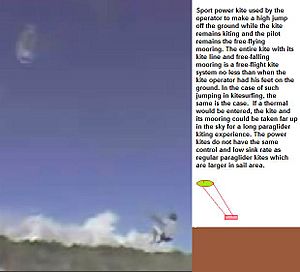Kite mooring facts for kids
Kite mooring is a special way to keep a kite secure while it's flying. A kite has two main parts: its wing (the part that catches the wind) and its kite line (the string). To make a kite fly, its line needs to be attached to something that stays still or moves. This creates tension in the line, which helps the kite get lift (the force that pushes it up) and drag (the force that pulls it back), allowing it to soar in the sky.
Sometimes, governments have rules about flying big kites or balloons in certain areas, like near airports. These rules help keep the skies safe for everyone. For example, in the United States, there are rules for how some kites and balloons can be flown. These rules usually apply to specific airspaces and not to all places where kites are flown.
Contents
Tying a Kite to Something Still
When a kite's lines are tied to an object that doesn't move, like a tree or a pole, it's called static mooring. If you're flying a kite this way, you are responsible for making sure it's safely secured.
It's important to moor kites properly because the wind can pull very hard on the line. If the kite isn't tied down well, the line could break or pull its mooring loose. This could cause damage or even hurt someone if the kite flies away unexpectedly.
Anchoring Kites to the Ground
To safely tie a kite to the ground, you can use different kinds of anchors. Some kite shops sell special stakes for this. You can also find strong metal stakes, like those used to tie up dogs, that work well for some kites. It's always a good idea to think about how strong the wind is and how much pull the kite line will have. This helps make sure the kite stays safely anchored.
Moving with a Kite
Sometimes, a person holds a kite line and moves their hands to control the kite, like in kite fighting or stunt flying. They might also walk with or against the wind. These are all examples of mobile or dynamic kite mooring because the person holding the kite is moving.
Other ways to move with a kite include:
- Being pulled by a scooter or bicycle.
- Riding a skateboard.
- Being towed across water on a surfboard or kiteboard.
- Having a kite pull a boat or even a large cargo ship!
- Letting a kite pull a floating object across a pond or lake.
Some people even attach themselves to very large kites and let the kite pull them across water, sand, or grassy fields. When a person jumps off a hill or mountain with a large kite wing and flies, it's called hang gliding. Since the pilot is moving, this is also a type of dynamic mooring.
Handling Kite Lines Safely
Kite lines are often stored on special devices called reels. These reels become part of the mooring system. When a person holds a reel, they can let out more line or wind it back in. The reel and how the line is handled are very important for flying a kite successfully. For very large kites, like those used to pull cargo ships, the reels need to be super strong to handle the huge forces on the lines.
It's important to handle kite lines carefully to keep them in good condition. If a line gets twisted too much or isn't wound onto the reel correctly, it can get damaged. Kite flyers pay close attention to how they store their lines. Sometimes, they release the tension from the lines before putting them away.
To keep everyone safe and make sure the kite lines last, it's important to avoid:
- Too much twisting.
- Burning or rubbing.
- Too much pressure.
- Cuts, tangles, or knots.
These things can weaken the line. When a kite is tied to things like control bars, poles, stakes, anchors, or reels, all these parts need to be strong and reliable. The entire mooring system must work perfectly during all parts of the flight.
Sometimes, reels are used for special purposes, like generating electricity from the kite's pull. When launching a hang glider, the timing of the reel releasing the line is very important. Some hang gliders are even launched from flat ground using reels powered by scooters!
See also


